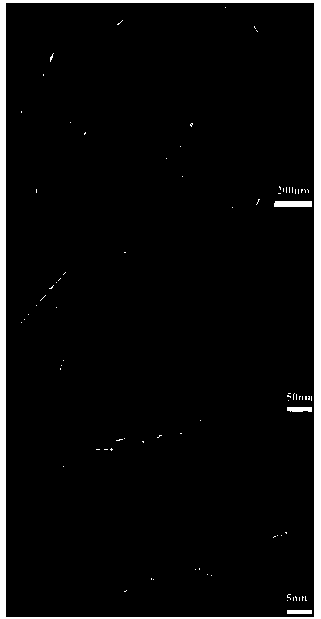Composite cadmium sulfide heterojunction photocatalyst preparation method
A photocatalyst and heterojunction technology, applied in physical/chemical process catalysts, chemical instruments and methods, inorganic chemistry, etc., can solve the problems of poor adsorption performance, photochemical instability, limited photocatalytic activity of pure CdS, etc. To achieve the effect of promoting visible light catalytic reaction, easy to implement, and shape controllable
- Summary
- Abstract
- Description
- Claims
- Application Information
AI Technical Summary
Problems solved by technology
Method used
Image
Examples
Embodiment 1
[0018] (1) Preparation of CdS by solvothermal method. First, under ultrasonic treatment, thiourea and CdCl 2 Disperse in 10 mL of ethylenediamine, respectively, and continue sonication. The mixture was transferred to a 100 mL Teflon autoclave, sealed and kept at 160 °C for 48 h. After natural cooling to room temperature, the solid product was manually collected and thoroughly washed by centrifugation with deionized water and dried at 60 °C for 12 hours to obtain CdS nanorods.
[0019] (2) Ag:ZnIn 2 S 4 / CdS heterojunction photocatalyst synthesis. Disperse 200 mg of CdS in 50 mL of deionized water under ultrasonic conditions, then add 282 μL of 0.05 mmol / mL zinc acetate solution, 282 μL of 0.1 mmol / mL indium acetate solution, 104 μL of 0.8 mmol / L silver nitrate solution, and 170 μL of 0.01 mmol / mL L-cysteine and sonicate 10mim. The mixture was transferred to a 100 mL Teflon reaction kettle, and 568 μL of 0.01 mmol / mL thioacetamide solution was added and magnetically sti...
Embodiment 2
[0021] As described in Example 1, the difference is that 564 μL of 0.05 mmol / mL zinc acetate solution, 564 μL of 0.1 mmol / mL indium acetate solution, 208 μL of 0.8 mmol / L silver nitrate solution, and 340 μL of 0.01 mmol / mL L-cysteine, 1136 μL 0.01 mmol / mL thioacetamide solution, the final catalyst contains 2 wt% Ag:ZnIn 2 S 4 2 wt% of Ag:ZnIn 2 S 4 / CdS.
Embodiment 3
[0023] As described in Example 1, the difference is that 846 μL of 0.05 mmol / mL zinc acetate solution, 846 μL of 0.1 mmol / mL indium acetate solution, 312 μL of 0.8 mmol / L silver nitrate solution, and 510 μL of 0.01 mmol / mL L-cysteine, 1704 μL 0.01 mmol / mL thioacetamide solution, the final catalyst contains 3 wt% Ag:ZnIn 2 S 4 3 wt% of Ag:ZnIn 2 S 4 / CdS.
PUM
 Login to View More
Login to View More Abstract
Description
Claims
Application Information
 Login to View More
Login to View More - R&D
- Intellectual Property
- Life Sciences
- Materials
- Tech Scout
- Unparalleled Data Quality
- Higher Quality Content
- 60% Fewer Hallucinations
Browse by: Latest US Patents, China's latest patents, Technical Efficacy Thesaurus, Application Domain, Technology Topic, Popular Technical Reports.
© 2025 PatSnap. All rights reserved.Legal|Privacy policy|Modern Slavery Act Transparency Statement|Sitemap|About US| Contact US: help@patsnap.com

